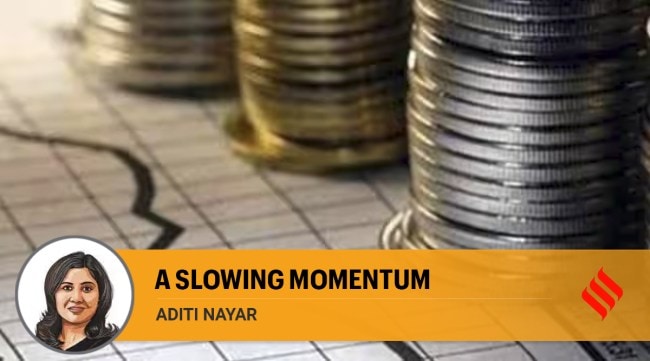Opinion Why India’s economic growth may lose pace in the second half of the year
Food inflation, erratic monsoon, contraction of exports are some of the reasons for this prediction
 ICRA expects the GDP growth to slow down to around 4.5-5 per cent in the second half, well below the MPC’s estimates of 5.7-6 per cent. (Representational Image)
ICRA expects the GDP growth to slow down to around 4.5-5 per cent in the second half, well below the MPC’s estimates of 5.7-6 per cent. (Representational Image)
A month has passed since the GDP data for India for the first quarter was released, allowing commentators sufficient time to analyse. With another quarter on the verge of completion, it is appropriate to look ahead and glean what the rest of the year holds for the economy.
Looking back, the economy grew at 7.8 per cent in the first quarter of 2023-24, up from 6.1 per cent in the fourth quarter of 2022-23, amid a supportive base and robust domestic demand. Regardless of the debates, the country was the fastest growing major economy in the world in that quarter. While we expect India to retain this tag, there are a few reasons why the pace of growth will moderate over the next few quarters.
The first is the base effect. This will outweigh the healthy momentum in economic activity that has been visible in the first two months (July-August) of the second quarter. For instance, the year-on-year growth in the ICRA Business Activity Monitor, our in-house composite index of high frequency indicators, had risen from an average of 7.2 per cent in the first quarter to 8.1 per cent in July and further to a six-month high of 10.7 per cent in August.
Early data in September also suggests a continuation of these positive trends. We expect India’s GDP growth to print at around 7 per cent in the second quarter, exceeding the Monetary Policy Committee’s estimate of 6.5 per cent. In our assessment, the anticipated fall from the 7.8 per cent in the first quarter is largely on account of the dissipation of the favourable base.
However, these robust growth prints are unlikely to sustain in the second half of the year. ICRA expects the GDP growth to slow down to around 4.5-5 per cent in the second half, well below the MPC’s estimates of 5.7-6 per cent. In addition to a further normalisation of the base, this will be led by a multitude of factors, some of which are exogenous.
The monsoon has been particularly erratic this year with temporal and spatial deviations manifesting into an unevenness in kharif sowing across various crops, with critical lags in items such as pulses. Moreover, a dry August may impact yields and thereby, kharif output and farm incomes, and have consequences for the food inflation.
The sub-par monsoon has dampened reservoir levels well below their historical averages. This does not augur well for the timely onset of rabi sowing activity, which would influence yields of the next crop as well. As a result, rural demand is expected to be cautious in the months ahead, reversing the signs of nascent improvement in recent months.
After several quarters of steady improvement, urban consumer sentiment has levelled off as per the RBI’s latest survey. We think that food inflation will play a pivotal role in guiding festive spending this year, unlike 2022, which had seen a more widespread demand for festivities after two years of the pandemic. Further, the impact of the cumulative monetary tightening by the RBI is likely to weigh on discretionary spending of borrower households, and the growth prospects in the second half of the year. In addition, consumer spending is likely to remain uneven, with relatively robust demand for services and discretionary items for those in the higher income brackets, amidst more circumspect spending by other income groups.
Amidst patchy demand, narrowing differentials with year-ago commodity prices are estimated to impact the growth in value added terms. Global commodity prices had spiked immediately following the Russia-Ukraine conflict in the first five months of 2022-23, before cooling off gradually thereafter. This is expected to have boosted the growth in value added in the first half of 2023-24. However, as the year-on-year gap is likely to narrow in the second half, and along with the recent spike in crude oil prices, the benefits of commodity prices on margins would compress.
India’s merchandise exports had contracted during the first quarter of 2023-24, and growth in services exports slowed down sharply. We project total exports (merchandise and services) to witness a contraction in the second half because of tepid external demand. This implies that the drag on GDP growth on this account will sustain.
The central and the state governments have been prescient in front-loading capex. This has supported economic activity in the first half. However, we are apprehensive that the momentum of capex and project execution may undergo a slowdown as we approach the general elections. This would weigh on GDP growth, particularly towards the end of the fiscal.
We expect India’s GDP to expand by 6 per cent for the full year, and our baseline estimate places growth at 6.2 per cent in 2024-25. In addition to the usual triggers such as monsoon, commodity prices and geopolitics, much will depend on the outcome of the next election.
The writer is Chief Economist, Head – Research & Outreach, ICRA Limited






